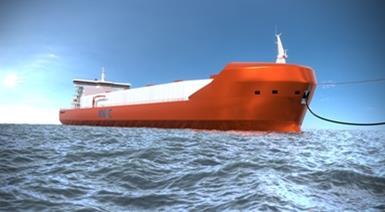Knutsen NYK Carbon Carriers (KNCC) is accelerating the development of its proprietary ambient liquefied carbon dioxide (CO2) transportation technology after it received an AiP at Nor-Shipping.
KNCC’s ambient liquefied CO2 concept received an Approval in Principle from DNV at Nor-Shipping in April 2022. The proprietary solution permits the transportation of liquefied CO2 at high (35-45 bar) pressures, and at an ambient temperature of 0-10 degrees C. The ambient liquefied CO2 concept offers an elegant solution to the challenge of transporting liquefied CO2 without requiring the development of cryogenic containment systems.
Testing is expected to begin once a new lab in Norway is completed in Q3 2022, Per Lothe, Director of Knutsen NYK Carbon Carriers told The Motorship. The company plans to obtain results from CO2 testing by the second or third quarter of 2023. This will demonstrate the applicability of the technology that KNCC has developed as part of its PCO2 concept.
By transporting the gas in a liquid phase under ambient conditions, the technology eliminates the cost of cooling the gas to a cryogenic level and reduces the weight of the storage tank required aboard the carrier. This in turn is expected to permit the construction of larger-sized carriers of up to 80,000 cbm in the future.
“Per Lothe, Director of Knutsen NYK Carbon Carriers told The Motorship the technology eliminates the cost of cooling the gas to a cryogenic level and reduces the weight of the storage tank required aboard the carrier.” “/ / 
Source: NYK
Per Lothe, Director of Knutsen NYK Carbon Carriers told The Motorship the technology eliminates the cost of cooling the gas to a cryogenic level and reduces the weight of the storage tank required aboard the carrier.
The solution envisages the transportation of bundles of vertically stacked small diameter cylinders based on pipeline fabrication design principles, rather than larger cylindrical tanks. The use of small diameter cylinders mitigates the risk of pressure variations within the tubes, ensures operations avoid dry ice formation, and eliminates sloshing effects of LCO2 in part or fully loaded condition. It is no coincidence that the solution resembles some compressed natural gas (CNG) transportation concepts, as it draws upon a proprietary Knutsen PNG design from the early 2000s.
The Motorship notes that liquid CO2 has a higher density than other liquefied gases, with a density of 800 to 900 kg/m3, compared with 500 kg/m3 for gases such as LNG or LPG. Previous cryogenic Type C tank solutions approved by DNV (see The Motorship, December 2019) employed 19 bar with a cryogenic temperature of -30 degrees C.
Regulatory Environment
When DNV began to consider the proposed vessel design, it soon became clear that the ambient LCO2 solution was technically feasible, but there were some challenges to ensure that it was permissible under the existing regulatory framework, Johan Tutturen, Vice President, Special Projects – Gas at DNV told The Motorship.
Unlike some other liquefied gaseous cargos, LCO2 is already included in regulations covering gas cargos. The IMO’s MSC amended the IGC Code to include liquefied CO2 in the code in 2006.
“Knut Ørbeck-Nilssen, DNV Maritime CEO, presented the AiP to Trygve Seglem, owner of Knutsen, Svein Steimler, Managing Executive Officer of NYK Line, Anders Lepsøe, CEO of KNCC, and Per Lothe, the Technical Advisor in KNCC.” “/ / 
Source: DNV
Knut Ørbeck-Nilssen, DNV Maritime CEO, presented the AiP to Trygve Seglem, owner of Knutsen, Svein Steimler, Managing Executive Officer of NYK Line, Anders Lepsøe, CEO of KNCC, and Per Lothe, the Technical Advisor in KNCC.
“The existing rules for the transportation of compressed natural gas did not envisage the transportation of a liquid in a gas containment system, which is the basis of KNCC’s ambient CO2 transportation concept,” Tutturen added. A particular focus was on approving the containment system as existing high-pressure LCO2 solutions based on conventional tank design have a number of limitations.
“We finally came up with a hybrid solution combining the best of two worlds,” Tutturen said, which meant we could accept the ambient CO2 system based on existing IGC and CNG rules.
The international regulatory environment governing international shipments of CO2 has evolved. “Limitations on the transportation of CO2 between the UK and Norway have been lifted,” Tutturen said, “but if we need to transport, for instance, CO2 from Australia to Norway, then I think the governments need to agree on some terms and conditions.”
The Motorship notes that an amendment to article 6 of the London Protocol was passed in 2009 to permit international shipments of carbon dioxide, but it has not yet been ratified by two-thirds of contracting parties. However, a resolution to permit international exports of carbon dioxide under certain circumstances was passed by parties to the London Convention in October 2019.
Economics of the concept
The concept also offers potential advantages during the offshore injection phase, where the liquefied CO2 will be injected at the wellhead, Lothe adds. The concept is intended to maintain a uniform product across the LCO2 transportation chain, reducing variations in pressure, temperature and state between capture and injection.
Cumulatively, the refinements are expected to result in “double-digit percentage savings” in the cost of offshore carbon liquefaction and transportation, compared with competing cryogenic strategies.
Minimising costs for the offshore carbon capture and storage (CCS) sector is particularly important as the economic viability of the emerging market will depend upon costs remaining below a potential carbon levy.





